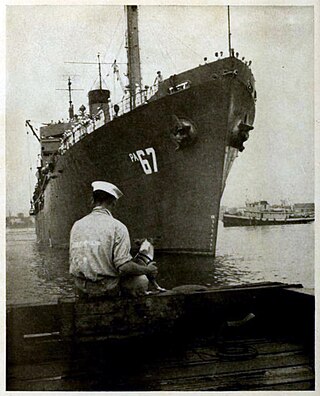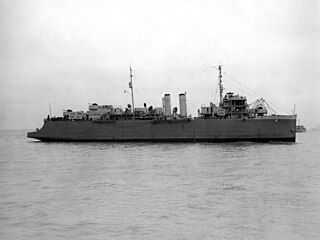Service history
After a brief shakedown, the cargo ship got underway on 11 November, for Hawaii. At Pearl Harbor, she was assigned for duty to Service Squadron 8, US Pacific Fleet. The ship discharged her cargo and then entered the Pearl Harbor Navy Yard for an overhaul of her main engines and boilers. Azimech was on keelblocks for 16 days, then began loading cargo. She set sail on 28 December, for the Gilbert Islands.
Supporting Tarawa operations
Azimech reached Tarawa on 8 January 1944, and began unloading her cargo. The process was hampered by frequent enemy air attacks and reefs in the lagoon which permitted the ship to unload only at high tide. Azimech made additional stops at Makin and Apamama Islands before heading back to Pearl Harbor. After a brief stop in Hawaii, Azimech continued on to the US West Coast and moored at San Pedro, California, on 6 March. Following an availability period at Terminal Island from 10 March until 9 April, she filled her holds with cargo at Oakland, California, and began the voyage back to Hawaii on 26 April.
Providing service at Majuro and Eniwetok
On 7 May, Azimech sailed from Pearl Harbor with a convoy bound for Majuro. They reached that naval base on 18 May, and reported to Service Squadron 10 for duty. The cargo ship lay at anchor in Majuro lagoon, issuing stores to forces ashore, until 3 June, when she got underway for Eniwetok. After serving at that atoll until 24 August, she steamed back to Hawaii; paused for one day at Pearl Harbor; and then pushed on to the US West Coast.
Servicing Ulithi and Kossol Roads
The ship reached San Francisco, California, on 13 September, to begin reloading operations. While taking on cargo, she also received minor repairs and alterations before heading west again on 26 September. After stops at Pearl Harbor and Eniwetok, Azimech arrived at Ulithi on 2 November. She operated there until 16 November and then steamed in company with Compel to Kossol Roads. Two days later, the ships reached their destination, and Azimech began issuing supplies. On 5 December 1944, the vessel weighed anchor and traveled back to Pearl Harbor via Ulithi and Eniwetok.
Overhaul at the Puget Sound Navy Yard
Following the holidays, Azimech got underway for Seattle, Washington, and entered the Puget Sound Navy Yard on 16 January 1945, for repairs. On 15 February, she began steaming for Eniwetok and reached that atoll on 11 March. Following eight days at Ulithi, she set sail for the Ryūkyūs.
Supporting Okinawa and Guam
Azimech remained anchored off Kerama Retto from 18 to 29 April. On the latter day, she shifted berth to Hagushi beach, Okinawa, her base until 7 May, when she sailed for Guam. The cargo ship began loading cargo there on 24 May, and did not finish the task until 8 June. She then got underway for Ulithi and, on 10 June, anchored in that lagoon where she remained for the duration of the war.
Inactivation and decommissioning
On 23 August, Azimech shaped a course for the coast of southern California. Reaching San Pedro, California, on 15 September, the ship unloaded her ammunition and provisions to prepare for a yard period. She sailed again on 13 October, bound for Norfolk, Virginia. After transiting the Panama Canal on 25 October, Azimech reached Hampton Roads on 3 November.
She immediately began preparations for deactivation. The cargo ship moved to Baltimore, Maryland, on 21 November for a final yard period and was decommissioned on 11 December. Her name was struck from the Navy List on 3 January 1946.
The ship was subsequently laid up in the National Defense Reserve Fleet, James River Group, Lee Hall, Virginia. Azimech was sold for $80,007 on 12 September 1972, to Isaac Varela. She was delivered 8 December 1972, and subsequently scrapped in Spain.

USS Situla (AK-140) was a Crater-class cargo ship in the service of the United States Navy in World War II. It was the only ship of the Navy to have borne this name. It is named after the star Situla.

USS Grumium (AK-112/IX-174/AVS-3) was a Crater-class cargo ship and aviation supply ship in the service of the US Navy in World War II. Named after the star Grumium in the constellation Draco, it was the only ship of the Navy to bear this name.

The USS Alnitah (AK-127) was a Crater-class cargo ship in the service of the US Navy in World War II. Named a spelling variation of the star Alnitak in the constellation Orion, it was the only ship of the Navy to bear this name.
USS Tuscana (AKN-3) was an Indus-class net cargo ship in the service of the United States Navy in World War II. Probably named after a variant spelling of the constellation Tucana, it was the only ship of the Navy to bear this name.

USS Storm King (AP-171) was a Storm King class auxiliary transport of the United States Navy. She was designed as a troop carrier, and named after Storm King Mountain.

USS Burleson (APA-67), a Gilliam-class attack transport, was the only ship of the United States Navy to be named for Burleson County, Texas. Her keel was laid down on 22 April 1944 at Wilmington, California, by the Consolidated Steel Corporation under a Maritime Commission contract. She was launched on 11 July 1944 sponsored by Mrs. Darryl F. Zanuck, delivered to the Navy on 7 November 1944, and commissioned on 8 November 1944. The ship was named after a county in east central Texas about 60 miles due east of Austin.

USS Aquarius (AKA-16) was an Andromeda-class attack cargo ship in the service of the United States Navy. She was named after the constellation Aquarius. She was one of a handful of World War II AKAs manned by officers and crew from the United States Coast Guard. She served as a commissioned ship for 2 years and 9 months.

USS LST-31 was a United States Navy LST-1-class tank landing ship used exclusively in the Asiatic-Pacific Theater during World War II. Like many of her class, she was not originally named and is properly referred to by her hull designation. Later she was named for Addison County, Vermont. She was the only US Naval vessel to bear the name.

USS Weehawken (CM-12) was originally SS Estrada Palma – a car ferry built in 1920 by William Cramp & Sons of Philadelphia. It was acquired by the United States Navy on 15 June 1942; renamed Weehawken on 18 July 1942; converted to a minelayer by the Bethlehem Steel Co. at Hoboken, New Jersey; designated CM-12; and commissioned on 30 September 1942.
USS Vega (AK-17), was a Sirius-class cargo ship of the United States Navy, originally the Lebanon — a single-screw, steel-hulled Type 1022 freighter, built under a United States Shipping Board contract at Hog Island, Pennsylvania, by the American International Shipbuilding Co. Laid down on 8 July 1918, the ship was launched on 18 July 1919. Acquired by the Navy on 2 December 1921, she was renamed Vega and given the classification of AK-17. She fitted out for Navy service, and was commissioned at the Boston Navy Yard on 21 December 1921.

USS Sebec (AO-87) was a Escambia-class fleet oiler acquired by the United States Navy for use during World War II. She had the dangerous but necessary task of providing fuel to vessels in combat and non-combat areas primarily in the Pacific Ocean. For her valiant efforts, she received six battle stars during the war.

USS Auriga (AK-98) was an Auriga-class cargo ship, the only ship in her class, commissioned by the U.S. Navy for service in World War II, named after the constellation Auriga. She was responsible for delivering troops, goods and equipment to locations in the war zone.

USS Allioth (AK-109/IX-204/AVS-4) was a Crater-class cargo ship commissioned by the US Navy for service in World War II, named after Alioth, a star in constellation Ursa Major. She was responsible for delivering troops, goods and equipment to locations in the war zone.

USS Alkes (AK-110) was a Crater-class cargo ship commissioned by the US Navy for service in World War II, named after Alkes, a star in the Crater constellation. She was responsible for delivering troops, goods and equipment to locations in the war zone.
USS Alderamin (AK-116) was a Crater-class cargo ship commissioned by the U.S. Navy for service in World War II, named after Alderamin, the alpha star in constellation Cepheus. She was responsible for delivering troops, goods and equipment to locations in the war zone.

USS Ara (AK-136) was a Crater-class cargo ship commissioned by the US Navy for service in World War II. Ara is named after the constellation Ara. She was responsible for delivering troops, goods and equipment to locations in the Asiatic-Pacific Theater.

USS Ascella (AK-137) was a Crater-class cargo ship commissioned by the US Navy for service in World War II. Ascella was named after Ascella, a star in the constellation Sagittarius. She was responsible for delivering troops, goods and equipment to locations in the Asiatic-Pacific Theater.

USS Adria (AF-30) was an Adria-class stores ship in service with the United States Navy from 1944 to 1954. She was scrapped in 1977.

USS Alpine (APA-92) was a Bayfield-class attack transport in service with the United States Navy from 1943 to 1946.She was sold into commercial service in 1947 and was scrapped in 1971.

USS Audrain (APA-59) was a Gilliam-class attack transport that served with the US Navy during World War II.

















